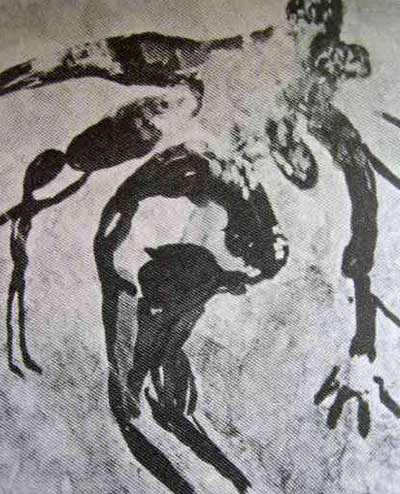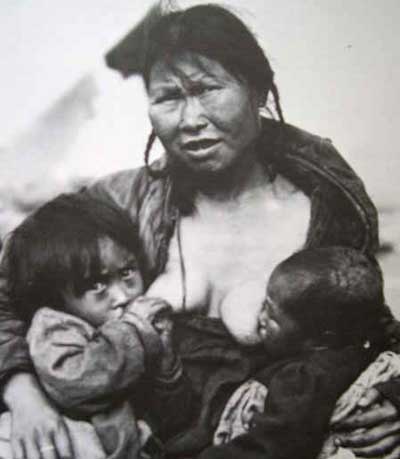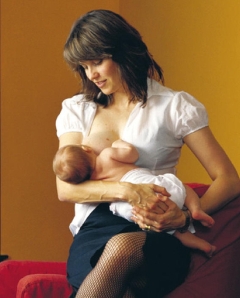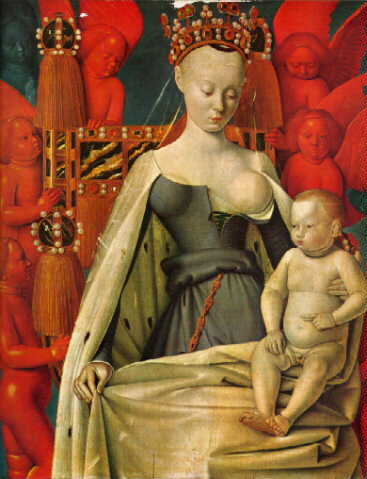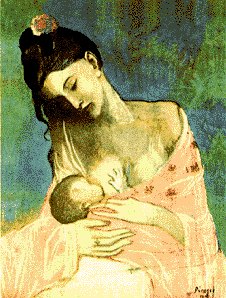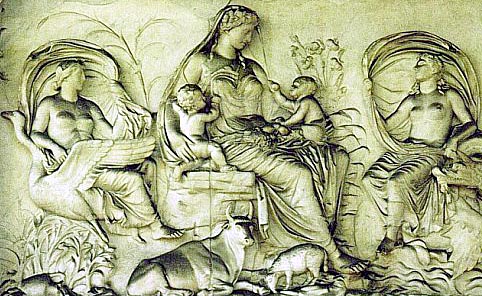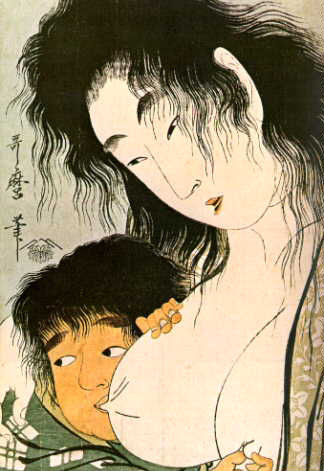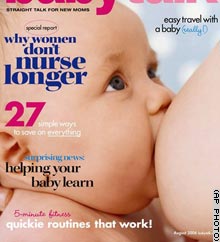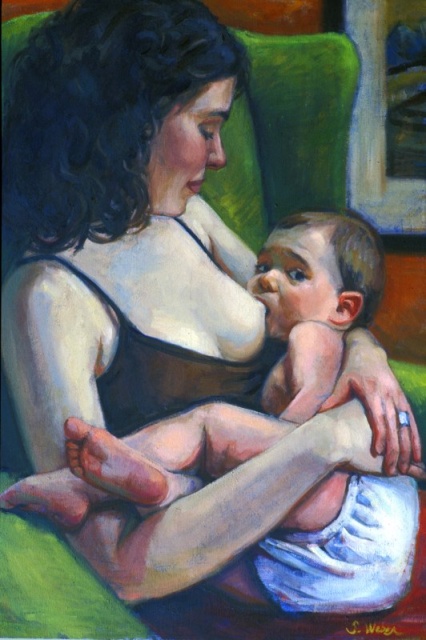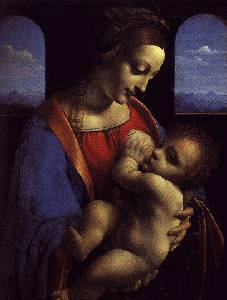| The History of Breastfeeding
The Health eZine - Motherhood
Mother's MilkBreastfeeding is the natural and normal means of feeding infants. It is a defining characteristic of being a mammal, and for most of human history and prehistory was universal, as there were no alternative foods for infants. The mother, or other lactating females, would have had to breastfeed the children for them to survive. A breastfeeding mother in public with her baby will often need to breastfeed her child. A baby's need to feed cannot be determined by a set schedule, so legal and social rules about indecent exposure and dress code are often adapted to meet this need. Many laws around the world make public breastfeeding legal and disallow companies from prohibiting it in the workplace, but the reaction of some people to the sight of breastfeeding can make things uncomfortable for those involved. Some breastfeeding mothers feel reluctant to breastfeed in public.
Breastfeeding in Early HistoryIn the Egyptian, Greek and Roman empires, women usually fed only their own children. However, breastfeeding began to be seen as something too common to be done by royalty, and wet nurses were employed to breastfeed the children of the royal families. This was extended over the ages, particularly in western Europe, where noble women often made use of wet nurses. Shared breastfeeding is still practised in many developing countries when mothers need help in feeding their children. According to some Brahminical literature, breastfeeding was practised in 2nd century India only after the fifth day, allowing the colostrum to be discarded and the true breast milk to flow. Traditionally, Japanese women gave birth at home and breastfed with the help of breast massage. Weaning was often late, with breastfeeding in rare cases continuing until early adolescence. After World War II Western medicine was taken to Japan and the women began giving birth in hospitals, where the baby was usually taken to the nursery and fed formula. In 1974 a new breastfeeding promotion by the government helped to boost the awareness of its benefits and the uptake has sharply increased. Japan became the first developed country to have a baby-friendly hospital, and as of 2006 has another 24 such facilities.
Breastfeeding in Canada
A 1994 Canadian government health survey found that 73% of Canadian mothers initiated breastfeeding, up from 38% in 1963. It has been speculated that the gap between breastfeeding generations in Canada contributes to lack of success of those who do attempt it: new parents cannot look to older family members for help with breastfeeding since they are also ignorant on the topic. Western Canadians are more likely to breastfeed; just 53% of Atlantic province mothers breastfeed, compared to 87% in British Columbia. More than 90% of women surveyed said they breastfeed because it provides more benefits for the baby than does formula. Of women who did not breastfeed, 40% said formula feeding was easier (the most prevalent answer). Women who were older, more educated, had higher income, and were married were the most likely to breastfeed. Immigrant women were also more likely to breastfeed. About 40% of mothers who breastfeed do so for less than three months. Women were most likely to discontinue breastfeeding if they perceived themselves to have insufficient milk. However, among women who breastfed for more than three months, returning to work or a previous decision to stop at that time were the top reasons. A 2003 La Leche League International study found that 72% of Canadian mothers initiate breastfeeding and that 31% continue to do so past four to five months. A 1996 article in the Canadian Journal of Public Health found that, in Vancouver, 82.9% of mothers initiated breastfeeding, but that this differed by Caucasian (91.6%) and non-Caucasian (56.8%) women. Just 18.2% of mothers breastfeed at nine months; breastfeeding practices were significantly associated with the mothers' marital status, education and family income. In Canada, the Canadian Charter of Rights and Freedoms gives some protection under sex equality. Although Canadian human rights protection does not explicitly include breastfeeding, a 1989 Supreme Court of Canada decision (Brooks v. Safeway Canada) set the precedent for pregnancy as a condition unique to women and that thus discrimination on the basis of pregnancy is a form of sex discrimination. Canadian legal precedent also allows women the right to bare their breasts, just as men may. In British Columbia, the British Columbia Human Rights Commission Policy and Procedures Manual protects the rights of female workers who wish to breastfeed.
Breastfeeding in CubaSince 1940, Cuba's constitution has contained a provision officially recognising and supporting breastfeeding. Article 68 of the 1975 constitution reads, in part: During the six weeks immediately preceding childbirth and the six weeks following, a woman shall enjoy obligatory vacation from work on pay at the same rate, retaining her employment and all the rights pertaining to such employment and to her labour contract. During the nursing period, two extraordinary daily rest periods of a half hour each shall be allowed her to feed her child.
Breastfeeding in the USA
A United States House of Representatives appropriations bill (HR 2490) with a breastfeeding amendment was signed into law on September 29, 1999. It stipulated that no government funds may be used to enforce any prohibition on women breastfeeding their children in Federal buildings or on Federal property. Further, U.S. Public Law 106-58 Sec. 647 enacted in 1999, specifically provides that "a woman may breastfeed her child at any location in a Federal building or on Federal property, if the woman and her child are otherwise authorized to be present at the location." A majority of states have enacted state statutes specifically permitting the exposure of the female breast by women breastfeeding infants, or exempting such women from prosecution under applicable statutes, such as those regarding indecent exposure. Most, but not all, state laws have affirmed the same right in their public places. By June 2006, 36 states had enacted legislation to protect breastfeeding mothers and their children. Laws protecting the right to nurse aim to change attitudes and promote increased incidence and duration of breastfeeding. Recent attempts to codify a child's right to nurse were unsuccessful in West Virginia and other states. Nowhere is breastfeeding in public illegal. In November 2006, Emily Gillette, a 27-year-old from Santa Fe, New Mexico was refused service in Burlington, Vermont after being asked to leave a Freedom Airlines flight by a flight attendant after Gillette refused to breastfeed her child under a blanket.
Breastfeeding in the UKA UK Department of Health survey found that 84% (about 5 out of 6 people) find breastfeeding in public acceptable if done discreetly, however 67% (2 out of 3) mothers are worried about general opinion being against public breastfeeding. To combat these fears in Scotland, a bill safeguarding the freedom of women to breastfeed in public was passed in 2005 by the Scottish Parliament. The legislation allows for fines of up to £2500 for preventing breastfeeding in legally permitted places.
Breastfeeding in PeruWhen a Peruvian immigrant in the USA had a photograph taken of the act of breastfeeding, American police forces alerted by a photo lab technician briefly considered it to be sexual abuse and production of child pornography, resulting in the mother's arrest and the seizure of her children: Victor Jaeger...says he was prepared to testify on the couple's behalf and explain what appears to him to have been a cultural misunderstanding. Jaeger, who grew up in Peru, says breast-feeding is culturally important in his native country and considered acceptable to do in public, particularly in the country's jungle regions. "My cousin sent me a picture of her newborn, and it was of the baby being breast-fed," he says. "As someone who has lived here for 20 years, I asked myself, 'Why did she send me that picture?' To her, it was nothing."
|




|
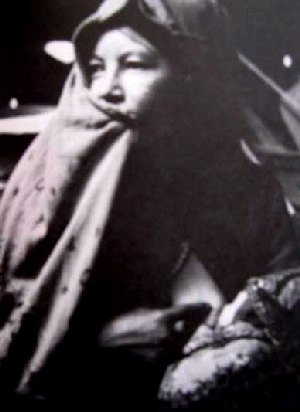
Breastfeeding in Developing nationsIn many countries, particularly those with a generally poor level of health, malnutrition is the majority cause of death in children under 5, with 50% of all those cases being within the first year of life. International organisations such as Plan International and La Leche League have helped to promote breastfeeding around the world, educating new mothers and helping the governments to develop strategies to increase the number of women exclusively breastfeeding. Traditional beliefs in many developing countries give different advice to women raising their newborn child. In Ghana babies are still frequently fed with tea alongside breastfeeding, reducing the benefits of breastfeeding and inhibiting the absorption of iron, important in the prevention of anaemia.
Breastfeeding Publicity, Promotion and LawIn response to public pressure, the health departments of various governments have recognised the importance of encouraging mothers to breastfeed. The required provision of baby changing facilities was a large step towards making public places more accessible for parents and in many countries there are now laws in place to protect the rights of a breastfeeding mother when feeding her child in public. The World Health Organization (WHO), along with grassroots non-governmental organisations like the International Baby Food Action Network (IBFAN) have played a large role in encouraging these governmental departments to promote breastfeeding. Under this advice they have developed national breastfeeding strategies, including the promotion of its benefits and attempts to encourage mothers, particularly those under the age of 25, to choose to feed their child with breast milk. Government campaigns and strategies around the world include:
However, there has been a long, ongoing struggle between corporations promoting artificial substitutes and grassroots organisations and WHO promoting breastfeeding. The International Code of Marketing of Breast-milk Substitutes was developed in 1981 by WHO, but violations have been reported by organisations, including those networked in IBFAN. In particular, Nestlé took three years before it initially implemented the code, and in the late 1990s and early 2000s was again found in violation. Nestlé had previously faced a boycott, beginning in the U.S. but soon spreading through the rest of the world, for marketing practices in the third world (see Nestlé boycott).
Guide To BreastfeedingBreastfeeding is the suckling of an infant and the natural method of feeding in mammals and humans.Most authorities believe that it is the best way of providing nourishment for a baby as the milk contains all the nutrients required in an easily digestible form, as well as antibodies to protect against infection and allergies.Since breast-feeding is regulated by the baby, over-feeding and early obesity is unlikely, and the milk is always warm, sterile, fresh and available.The fluid produced in the first few days after childbirth is called colostrum, and it is protein-rich, containing antibodies and a natural laxative to stimulate the baby's bowels.Milk production begins 3-5 days after childbirth, and is triggered by hormonal changes.Suckling stimulates the nerve endings in the Areola and the production of Prolactin and Oxytocin hormones from the pituitary gland. Prolactin stimulates the production of milk while oxytocin plays a part in the Let-Down Reflex, in which the muscle fibres surrounding the milk glands contract, moving milk to the milk ducts.Oxytocin also helps the Uterus return to normal size after childbirth.Breast-feeding helps mother lose the extra weight gained during pregnancy but does not appear to have any permanent effect on the size and shape of the breasts and lessens the risk of developing Breast Cancer in later life.Women who have had breast reconstruction surgery with silicone implants and breast augmentation may still be able to breastfeed.Women who have had reduction surgery may not be able to breastfeed if too many mammary ducts ahev been cut.Breastfeeding is not recommended if the mother has active tuberculosis or chickenpox infections as these can be passed on to the baby, as can the AIDS virus.Women taking some antibodies, tranquilizers, hormonal medicine, anti-cancer drugs, radioactive medicines or drinking more than 7 units of alcohol per day should avoid breastfeeding. During Breast feeding the breasts require special care, with particular attention to washing and drying.Creams and lotions can help prevent soreness and cracked nipplesIt is important that the baby is latched onto the breast correctly.It should have the nipple well back in the mouth with the lips around the areola.The mouth is then on the breast tissue instead of the nipple.The baby sqeezes the nipple against the palate with its tongue, and this draws milk into its mouth.An infant soon acquires this natural skill.Feeding on demand appears to be the best way of nourishment, and the baby should be allowed to feed from both breasts.Breastfeeding may act as a method of contraception as it changes the levels of hormones and prevents ovulation, but it is unreliable, particularly when the baby starts to be weaned.A woman may be ovulating even if menstrual periods are absent.Effectiveness in preventing pregnancy is 60-75%. Breastfeeding problems generally arise because of excess milk production, sore nipples or an infection.If too much milk is produced, the breasts become engorged.This is eased by feeding or expressing milk by hand or with a pump.Engorged breasts can make it difficult for the baby to latch on properly, and some milk may need to be expressed first.The condition can be eased by bathing the breasts in warm water, applying a hot compress and stroking.Engorgement can occur at any time if the breasts are not emptied of milk, eg., if the baby misses a feed.As mentioned above, breastfeeding occurs because of the stimulation of nerve-endings during suckling, resulting in the let-down reflex.Mnay women suffer from sore or cracked nipples when breast-feeding.This may be caused by incorrect latching-on or by allowing the baby to pull on yhe nipple, especially when it is releasing its hold on the breast. It is best to stop feeding from the affected breast and apply lotion or oil to the nipple, as advised by a doctor.Sore or cracked nipple heal faster when exposed to air.Cracked nipples can lead to infection, but using a breast shield allows the baby to feed, affording protection while healing occurs.The most common breast infection is Mastitis, but a Breast abscess may also form.A blocked milk duct in the nipple is a problem that can result from a bra that is too tight, engorged breasts or from blockage by dried milk.The breast may feel lumpy and tender, with reddened skin.The blockage may be cleared by feeding and massaging the breast above the affected duct, but to lessen the risk of an abscess a doctor's advice should be sought if the condition does not clear.
Troubleshooting Breastfeeding1. Retracted Nipples: If the nipples come out partially or not at all when gently stretched, it means you have retracted nipples, partially or fully.If diagnosed early, a simple 10ml syringe suction device or a breast pump will solve this problem.In case of slight retraction, you can slowly massage them with oil from the seventh month of pregnancy.Stretch them gently.This prevents retracted nipple.This routine keeps the nipples soft and erect so the chances of cracked or painful nipples are greatly reduced. 2. Sore Nipples: Incorrect attachment of the baby or frequent use of soap to clean the nipples gives rise to this condition.Excessive cleaning removes the natural protective oils, cause sore, chapped, cracked and tender nipples, with a posibility of fungal infection.This can be remedied by applying hind milk i.e. milk left in the breast after a feed as it has a natural fat content. 3. Breast Engorgement: If the breast feels full even after the baby is fed well, then, lightly apply some oil and gently squeeze out the excess milk.Since the squeezing out is painful, the mothers are not very keen to do this, to thier detriment later.Warm water fomentation of the back before removing excess milk helps a lot.If there are lumps at this time, then take some crushed ice and lay it on gauze strips on the painful breast.Applying Fuller's Earth mixed in water for about half an hour is very useful at such times.As the feeding cycle is established, diminish and vanish. 4. Leaking Breasts: Women, who have an active milk-ejection reflex, have the opposite breast leaking when feeding from one side.When working mothers think of the baby lovingly or percieve that it is the baby's feeding time, they complain of a leak.A simple gauze pad cut in a circle and stuffed in the brassiere helps in expressing the extra milk.
The Nursing Mother's DietA good nursing diet has nothing to do with the notions of foods being hot or cold for the baby.Consume a proper nutritive diet( a high energy and high fibre diet with sufficient fluid intake)comprising 2-3 glasses of milk, plenty of fruits, vegetables, sprouts, cereals, pulses and legumes.This along with galactogogues like asparagus, fenugreek, liquorice, dried ginger, dry fruits and cocnut kernel, help in secretion of adequate quantity of milk.Bananas along with saffron and crystal sugar are also very good galactogugues.These are excellent natural sources of minerals and vitamins.Take a glass of water or any other fluid just prior to feeding the baby.It helps greatly.Avoid fried, spicy foods and stick to home-made food.The very act of suckling, the "touch", and the flood of maternal emotions are best galactogogues.Maintaining a fuid intake of 13-14 glasses a day such as fruit juices, coconut water, butter-milk and plain water is extremely important.This helps in preventing constipation.Constipation can also be overcome by increasing the intake of fibre, green leafy vegetables and soaked black raisins.
When should I first feed my baby?You should give the child your breast the moment the baby is given to you, and you should insist on feeding the baby within its first half hour."Colostrum", the first feed, is a thick yellowish secretion.It is nature's startup pack for the baby.Very rich in proteins, minerals and vitamins, it also has, most importantly, the disease resistance antibodies.One should never let this elixir of life go waste.Even after a Caesarian section, breast-feed the baby as soon as the anaesthesia wears off.If the husband holds the baby to your breast, as you lie down, it has the additional bonus of father-child bonding.
What is the best feeding technique?When suckling, the baby should hold the areola in its mouth and not just the nipple.Hold the baby in the crook of your arm, with the baby's upturned face towards you.Make sure that the baby's mouth and chin are near the nipple.The baby should hold the areola and the nipple inside its mouth, with its lips curled out.The baby's chin should rest on your chest.To facilitate this, in the beginning, the mother should slightly raise the nipple and insert it in the baby's mouth, with the upper areola just covered by the lips.The baby will feel the urge to suckle and will start sucking strongly and will swallow properly.It will look calm and contented.Importantly, this method reduces pain in the nipple, which some mothers feel.After feeding or in between, do not abruptly remove the baby from the breast.Slowly insert your little finger in the baby's mouth, open it, and then gently remove the breast.This prevents injury to the nipples.While breastfeeding, always feed the baby from breast and only when it empties out, then switch the baby to the other.A simple way to remember this is to wear a bangle in the arm from which side you are feeding and then, at the next feed, switch over.It is a fallacy that the right breast has food and the left breast has water.The sooner this is dispelled the better or else engorgement and hardening of breasts will take place.Not only are these painful but also can have long-lasting side effects.Always burp the baby on your shoulder after every feed.
Should I feed my baby on demand?You should feed the baby only as and when it demands a feed.No timetables, please.Let the baby decide how long it wants to feed. I'm a working mother and want to regularly breast-feed my baby.Three months down the line, I will resume my job.How can I continue breast-feeding? The remedy has the best of both worlds-the benefit of breast milk for your baby and holding the job.Following some simple instructions will allow you to extract your own milk, for the baby, rpior to leaving for office.Morning, when the breasts are full, is the right time for this.Take a steel container having a 3-4" size mouth with a lid.Boil it in a large bowl so that it is disinfected.Remove it and keep it aside.Wash your hands and your breasts properly.Now slowly sqeeze the areola and the nipple evenly and from all sides, with thumb and index finger.The expelled milk is to be collected in the steel container.A circular movement ensures that the entire breast is emptied.Repeat this with the other breast.Cap the container tightly.The milk is now ready to use.This milk lasts for upto 8 hours at room temperature and 24 hours, if regrigerated.To feed, remove some quantity from the container in a bowl,if refrigerated.Then, keep the bowl in a deep dish having some warm water.This will warm the milk enough and now feed the baby using a spoon.After the feed, burp the child on your shoulder.Another level of bonding is established when the baby's carer takes over her feeding rituals.Initially, it might be a bit difficult to spoon-feed the baby and you might think that bottle-feeding is easier.However, that perception will change soon.
How will I know if my child is getting a proper feed?When a baby is only breast-fed and not even outside water is given to it, and if the baby urinates six or more times in a day(except for the first 4-5 days after birth, when the water percentage in the milk is lower), is active, sleeps after a feed and puts on adequate weight,(500-1000gms a month), you can be assured that the milk is sufficient.
Advantages Of Breast MilkOf many advantages, the foremost is that mother's milk is easily available, clean, uncontaminated and sterile.Moreover, it is available at a correct temperature for the baby's needs.It contains anti-infective factors which shield the baby from external infections.It contains what controls viral and bacterial infections in the baby's initial months. In rural areas, breast milk is used as eye drops in viral conjunctivitis and minor eye infections as a first aid. A healthy lactating mother secretes about 500ml of milk per day, and it might increase increase upto 700ml in the first year of lactation.The calorific value of breast milk is 70 per 100ml of milk and this fully meets the requirements of the infant. Lactoferrin, a protein in breast milk, provides considerable protection against intestinal and respiratory infections.This lactoferrin acts as a strong bacteriostatic so that the breast milk remains sterile for hours. Hence, a career woman can collect her milk in a clean, sterile bowl and this could be administered to the infant in her absence.The milk that is secreted during the first week is very rich in protein and protective antibodies.This is called colostrum, which is slightly creamish in colour and concentrated.This provides the maximum protection to the gastrointestinal system.But unfortunately, many are ignorant of the benefit of this valuable secretion.There is a myth prevailing about it, especially in rural areas of the developing countries.This is regarded as the first waste from the breast.So they express this milk and throw it away.They start feeding only when the milk secreted is thin and white-coloured. Human milk has less protein and hence, is more easily digestible than cow's milk.The intestinal mucosa of the baby during the first 2-3 months is very vulnerable to infections.During this early stage, if the baby is fed cow's milk, then due to its higher content of protein the baby might develop allergy to cow's milk.But one need not face this situation if the baby is exclusively breast-fed.Human milk is a rich source of carnitine which develops healthy liver activities.Breast milk also helps absorption of calcium and promotes brain growth.It has been proved that breast-fed children have higher IQ's than the deprived ones.It promotes an emotional bond between the mother and the child.The child recognises the mother through the sense of touch and this makes the baby feel more secure. Studies and research are proving the concept of "Touch Therapy" according to which the breast-fed child who enjoys the constant touch of its mother while nursing and sleeping grows up to be a confident and bright citizen.Hence, they advocate "No" to bottle and cradle.Moreover, breast-feeding is more convenient and also economic.No bottle sterilisation hassles, no preparation of artificial feeds.There are many misconceptions even amongst the educated that breastfeeding affects their figure.But this is not true.Breast feeding never alters a woman's figure. Another misbelief is that, when a child has mild diarrhoea, it is assumed that it has been caused by breast milk and thus, nursing is discontinued.However, it should be remembered that breast milk never causes diarrhoea.
Breastfeeding Myths And FactsAt Birth, the thick yellow milk should be thrown out. On the contrary, it is nature's start-up pack for the baby. Very rich in proteins, minerals and vitamins, it also has, most importantly, the disease resistance antibodies. If the mother has diarrhoea or fever, she should stop feeding. The mother's infection causes production of protective immunoglobulin, which are passed on to the baby.So, in fact, the feeding should continue. Breasts are small hence milk will be less. Breast size has no role in milk output, which is a hormonal process depending on the levels of oxytocin and pro-lactin.At the same time, the feelings of love and joy spur milk output. Breast feeding interferes with your figure. Nothing could be farther from the truth.In fact, breast-feeding causes rapid involution of the uterus, mobilises the body reserves into calories for the baby, and acts as nature's contraceptive.It is linked to reduced breast cancer risk. Working mothers should wean their babies to the bottle. Why deprive the baby? See the above section on working mothers. My baby was born to be nurtured by me in every way, and one of the most important is that he actually grows by being nourished by me. And so breast-feeding is an extension of the womb. When my child came out of my womb, the umbilical cord was cut. When I began breast-feeding I can remember distinctly feeling that a second cord was formed---the pyschic cord---from my heart to the child 's heart directly. It was almost physical---it was that strongly felt. When you are pregnant, the child is nourished by you all that time, and then it gets too big so it comes out, you should still hold it very close within your aura and your protection while you continue to nourish it from your body." - Breasts: Women Speak About Their Breasts and Their Lives, by Daphna Ayalah and Isaac J. Weinstock (Summit Books, NY 1979)
Babytalk magazine generates Controversy"I was SHOCKED to see a giant breast on the cover of your magazine," one person wrote. "I immediately turned the magazine face down," wrote another. "Gross," said a third. These readers weren't complaining about a sexually explicit cover, but rather one of a baby nursing, on a wholesome parenting magazine -- yet another sign that Americans are squeamish over the sight of a nursing breast, even as breast-feeding itself gains more support from the government and medical community. Babytalk is a free magazine whose readership is overwhelmingly mothers of babies. Yet in a poll of more than 4,000 readers, a quarter of responses to the cover were negative, calling the photo -- a baby and part of a woman's breast, in profile -- inappropriate. One mother who didn't like the cover explains she was concerned about her 13-year-old son seeing it. "I shredded it," said Gayle Ash, of Belton, Texas, in a telephone interview. "A breast is a breast -- it's a sexual thing. He didn't need to see that."
It's the same reason that Ash, 41, who nursed all three of her children, is cautious about breast-feeding in public -- a subject of enormous debate among women, which has even spawned a new term: "lactivists," meaning those who advocate for a woman's right to nurse wherever she needs to. "I'm totally supportive of it -- I just don't like the flashing," she said. "I don't want my son or husband to accidentally see a breast they didn't want to see." Another mother, Kelly Wheatley, wrote Babytalk to applaud the cover, precisely because, she said, it helps educate people that breasts are more than sex objects. And yet Wheatley, 40, who's still nursing her 3-year-old daughter, rarely breast-feeds in public, partly because it's more comfortable in the car, and partly because her husband is uncomfortable with other men seeing her breast. "Men are very visual," said Wheatley, of Amarillo, Texas. "When they see a woman's breast, they see a breast -- regardless of what it's being used for." Babytalk magazine's readership is overwhelmingly mothers of babies. Yet in a poll of more than 4,000 readers, a quarter of responses to the cover were negative, calling the photo -- a baby and part of a woman's breast, in profile -- inappropriate. One mother who didn't like the cover explains she was concerned about her 13-year-old son seeing it. "I shredded it," said Gayle Ash, of Belton, Texas, in a telephone interview. "A breast is a breast -- it's a sexual thing. He didn't need to see that." It's the same reason that Ash, 41, who nursed all three of her children, is cautious about breast-feeding in public -- a subject of enormous debate among women, which has even spawned a new term: "lactivists," meaning those who advocate for a woman's right to nurse wherever she needs to. "I'm totally supportive of it -- I just don't like the flashing," she said. "I don't want my son or husband to accidentally see a breast they didn't want to see." Another mother, Kelly Wheatley, wrote Babytalk to applaud the cover, precisely because, she said, it helps educate people that breasts are more than sex objects. And yet Wheatley, 40, who's still nursing her 3-year-old daughter, rarely breast-feeds in public, partly because it's more comfortable in the car, and partly because her husband is uncomfortable with other men seeing her breast.
See a giant breast on the cover of your magazine," one person wrote. "I immediately turned the magazine face down," wrote another. "Gross," said a third. These readers weren't complaining about a sexually explicit cover, but rather one of a baby nursing, on a wholesome parenting magazine -- yet another sign that Americans are squeamish over the sight of a nursing breast, even as breast-feeding itself gains more support from the government and medical community. Babytalk is a free magazine whose readership is overwhelmingly mothers of babies. Yet in a poll of more than 4,000 readers, a quarter of responses to the cover were negative, calling the photo -- a baby and part of a woman's breast, in profile -- inappropriate.
One mother who didn't like the cover explains she was concerned about her 13-year-old son seeing it. "I shredded it," said Gayle Ash, of Belton, Texas, in a telephone interview. "A breast is a breast -- it's a sexual thing. He didn't need to see that." It's the same reason that Ash, 41, who nursed all three of her children, is cautious about breast-feeding in public -- a subject of enormous debate among women, which has even spawned a new term: "lactivists," meaning those who advocate for a woman's right to nurse wherever she needs to. "I'm totally supportive of it -- I just don't like the flashing," she said. "I don't want my son or husband to accidentally see a breast they didn't want to see." Another mother, Kelly Wheatley, wrote Babytalk to applaud the cover, precisely because, she said, it helps educate people that breasts are more than sex objects. And yet Wheatley, 40, who's still nursing her 3-year-old daughter, rarely breast-feeds in public, partly because it's more comfortable in the car, and partly because her husband is uncomfortable with other men seeing her breast. | |
